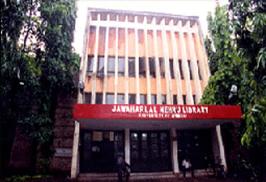|
History:

In
1879, the library consisted mainly of the following collections
:-
1) a number of miscellaneous books (mostly historical and
biographical) presented by the Government in 1864, when the old
library of the East India Company, was removed to the India
Office some of the books being divided among the Indian
Universities.
2) Dr. John Wilson's Collection : This was purchased in 1876 by
the University from the heirs of Dr.Wilson (after whom the
Wilson College is named) and consisted mainly of Orientalia, and
books on travel and theology.
3) books presented to the University.
In the early years, the library had an annual book budget of Rs.
400 but this was later discontinued so that in about 1900 we
find that " the only additions now made to the library are the
official publications sent in by the local Government and the
Government of India and some school and college books presented
by publishers." The library then had 4,504 books and 214
manuscripts.
It was only after Sir Alfred Hopkinson's report of 1914 that
attention began to be paid to the planning and development of
the library. Sir Alfred suggested the appointment of an
experienced Library. Committee under the control of the
University Syndicate control of the University Syndicate.
The annual grant to the library was renewed but the amount was
not fixed and it varied according to circumstances. In 1930, the
library got a non-recurring grant of Rs. 50,000 from the
Government to strengthen its collection for post-graduate work.
In July 1932, a book grant of Rs. 8,500 was made. It was
increased to Rs. 18,500 in the following year and the year later
to Rs. 20,000. Thanks to the various loans and donations
including from the U.G.C., the India Wheat Loan Fund and other
individuals and organizations, the library's stock of books and
periodicals has been steadily growing and the library today is
literally bursting through its seams, even though four tier
annexe to the main library building to provide space for
2,20,000 books was built in 1959.
The library is particularly rich in various reference materials,
bibliographical tools, books on Mathematics, the Social Sciences
and Indology. It also has a valuable and rare collection of back
files of periodicals in Sciences, the Social Sciences and
Indology.
Roychand donated another Rs.
2,00,000/- to build a clocktower to perpetuate the memory of his
mother Rajabai. The Rajabai Tower Library saw the light of day
on 27th February 1880 when it was formally opened to readers.
The Library made a humble beginning with government books of the
East India Company; Dr. John Wilson's collection (purchased in
1876 by the University from Dr. Wilson's heirs) of books on
Orientalia Travel & Theology.
Due to shortage of space another Campus of the University was
set up at Vidyanagari in 1968 and a unit of the University
Library was constructed in July 1971 therein. The new Library
building named Jawaharlal Nehru Library, was constructed and was
inaugurated on 18th October, 1976 and expanded in phases. Now it
functions in a full fledged manner and caters to the library
needs of students, scholars, faculty of all the departments
situated on Campus. Today it has a stock of nearly 8 lakhs
seventy thousand books, periodicals and other material.
Jawaharlal Nehru Library (JNL) at
Vidyanagari is built on modern architectural principles of
modular construction The collection here is divided into social
sciences; pure and applied sciences and humanities. Separate
stacking and reading rooms for these collections facilitate easy
access.
The access to the Rajabai Tower Library
collection is via catalogues except for researchers and teachers
who are extended browsing facility, whereas JNL offers open
access i.e. browsing in the stacks for all the readers alike.
Fort Library extends membership to undergraduate students as
well.
|

